- Miro: Visual collaboration with tools like Kanban boards and Gantt charts.
- Google Drive: Real-time document editing and secure cloud storage.
- Slack: Organized communication with channels and integrations.
- Monday.com: Project management with visual timelines and task tracking.
- ClickUp: Customizable workflows and built-in chat for seamless coordination.
- Microsoft Office Online: Familiar tools like Word and Excel with cloud functionality.
- Shortcut: Agile project management for software development teams.
- Figma: Cloud-based design collaboration with real-time editing.
- Zoom: Video conferencing with smart recording and virtual whiteboards.
- GTFO.co: Travel planning resources tailored for digital nomads.
Quick Comparison
| Tool | Best For | Key Features | Pricing (Starting) |
|---|---|---|---|
| Miro | Visual collaboration | Diagrams, Kanban boards, integrations | Free/$8 per user |
| Google Drive | File sharing | Real-time editing, offline access | Free/$6 per user |
| Slack | Communication | Channels, integrations, mobile app | Free/$7.25 per user |
| Monday.com | Project management | Timelines, task tracking, automations | Free/$8 per user |
| ClickUp | Custom workflows | Gantt charts, built-in chat, integrations | Free/$5 per user |
| Microsoft Office Online | Familiar tools | Real-time editing, OneDrive integration | Free/$6 per user |
| Shortcut | Software development | Kanban boards, GitHub integration | Free/$8.50 per user |
| Figma | Design collaboration | Interactive prototyping, version control | Free/$12 per user |
| Zoom | Video conferencing | HD calls, smart recording, virtual whiteboard | Free/$14.99 per user |
| GTFO.co | Travel planning | Flight deals, eSIM services, visa assistance | Free |
These tools address common challenges like time zones, connectivity, and secure data sharing. Test free trials to find which ones fit your workflow best.
10 Best Collaboration Tools for Hybrid and Remote Teams
Key Features for Digital Nomad Collaboration Tools
When choosing collaboration tools for remote work, digital nomads should focus on platforms that provide essential features to meet their unique needs. Here's what to prioritize in 2025's top solutions:
Real-Time Collaboration and Communication
The best tools allow instant communication and teamwork, offering features like chat, video calls, and live document editing. Platforms such as Miro and Google Drive are great examples, enabling teams to collaborate effectively from anywhere [1].
File Management
Reliable cloud storage with features like version control, offline access, and selective syncing is a must. These options ensure digital nomads can access and manage files smoothly, even with spotty internet connections.
Project Management
Tools like Monday.com and ClickUp provide task tracking, visual timelines, and customizable workflows to keep projects organized and on schedule [1]. These capabilities help nomads stay productive while juggling remote teams and deadlines.
Security
Strong security measures, including two-factor authentication, encryption, and detailed access controls, are critical for protecting sensitive data [3]. For digital nomads, these features offer peace of mind, no matter where they work.
Cross-Platform Accessibility
The ability to switch seamlessly between desktops, mobile devices, and web browsers is essential. This ensures productivity stays consistent, whether working on a laptop or a smartphone.
Integration and Customization
Platforms that connect with other essential tools and allow workflow customization are invaluable [1]. This adaptability lets digital nomads tailor their systems to fit their work habits and preferences.
These features are key to staying productive and secure while working across different time zones and devices. Next, we'll dive into the top collaboration tools that meet these needs for digital nomads in 2025.
1. Miro
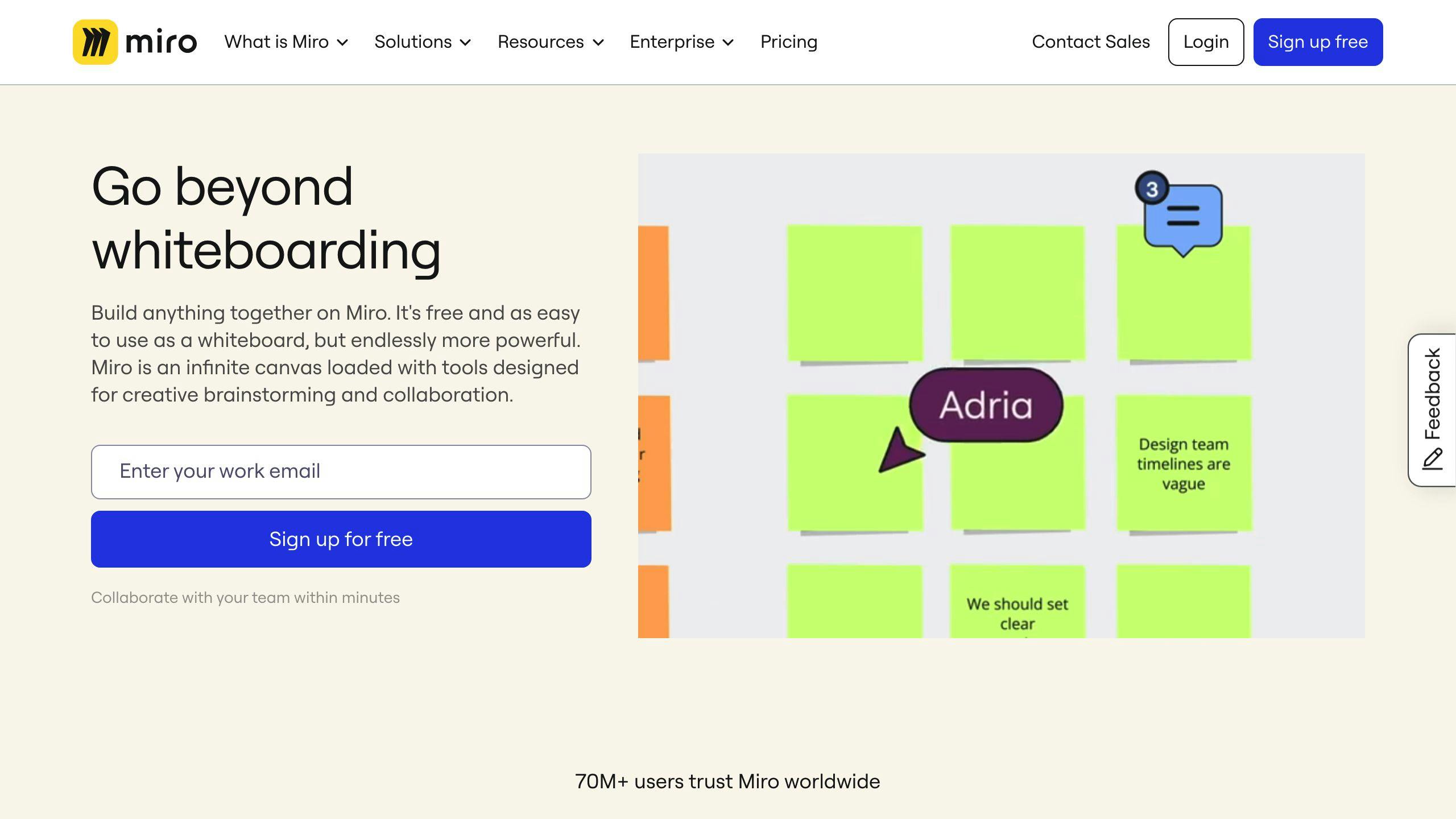
Miro is a platform designed to simplify remote teamwork, especially for digital nomads. At its core is a digital canvas where teams can work together in real-time to create diagrams, workflows, and mind maps. This feature helps cut down on delays often faced in remote collaboration.
It also includes tools like Kanban boards, Gantt charts, and customizable templates to help manage projects and organize complex workflows. Plus, Miro integrates seamlessly with tools like Slack, Google Drive, and Trello, boosting productivity for remote teams.
Security is a priority with features like two-factor authentication, encryption, and adjustable access controls. Miro works smoothly on laptops, tablets, and smartphones, ensuring a consistent experience across devices. Its file-sharing and version control tools also make document management easier for remote teams.
Thanks to its visual-first design, Miro is a great choice for creative and strategic teams. However, for those focused on file storage and document management, pairing it with Google Drive can be a smart move.
2. Google Drive
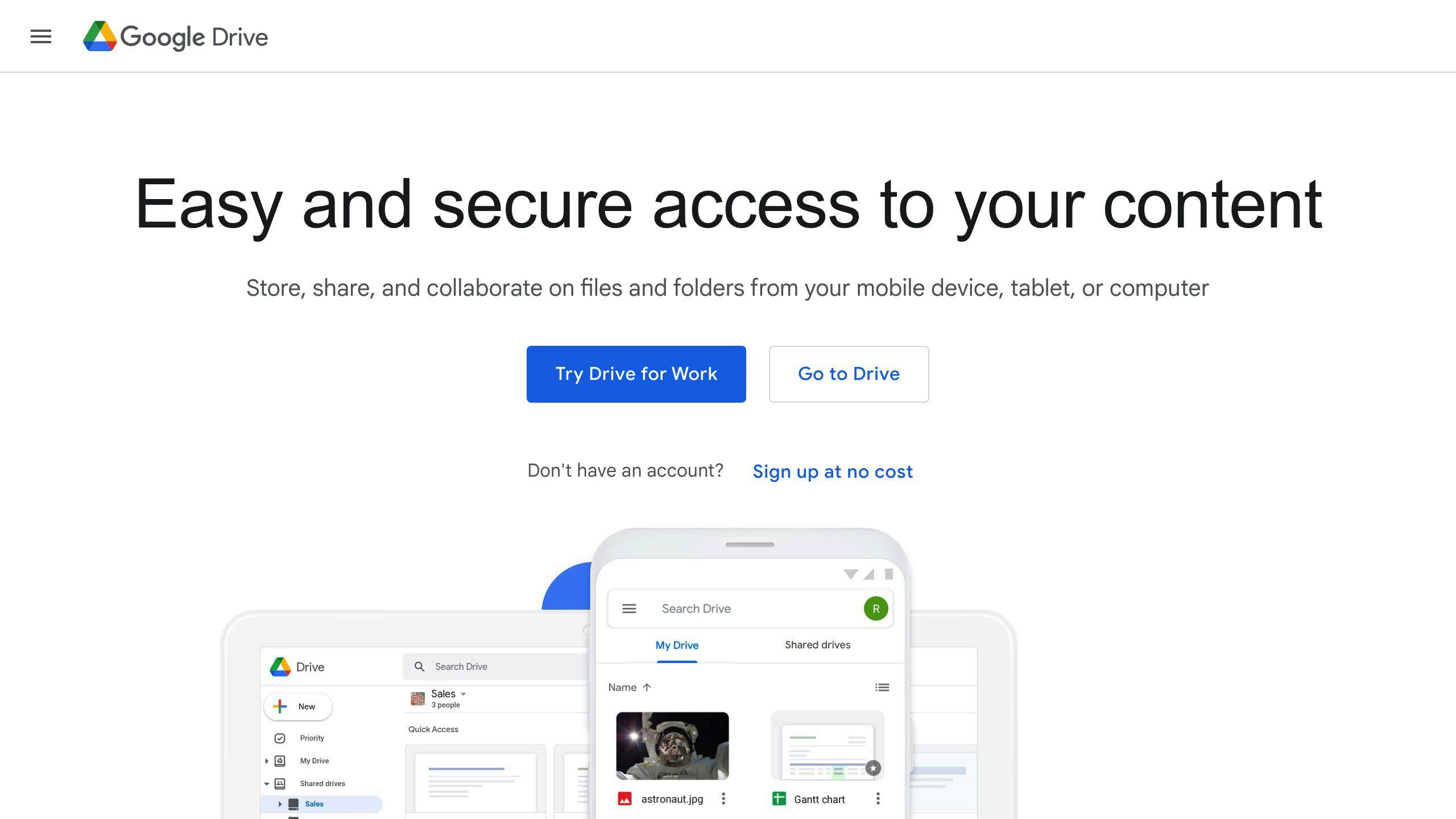
Google Drive is a go-to platform for remote collaboration, especially for digital nomads. Its file access settings - allowing users to view, comment, or edit - make it easy to share and work securely with clients and contractors. With built-in tools like Google Docs, Sheets, and Slides, you can edit documents in real time without downloading files. Plus, its version history feature makes it simple to track or roll back changes [1].
For those constantly on the move, Drive's offline access and syncing capabilities ensure you can stay productive, even without an internet connection. It also connects effortlessly with platforms like Slack and Trello, streamlining workflows and creating a centralized workspace [1][2]. To keep your data safe, Drive offers features like two-factor authentication, encryption, access controls, and automatic backups [3].
What sets Google Drive apart is its integration within the Google ecosystem, providing advanced document management and collaboration tools that go beyond basic cloud storage [1][4]. While Drive shines in file organization and teamwork, pairing it with tools like Slack for real-time communication can be a game-changer for digital nomads.
3. Slack
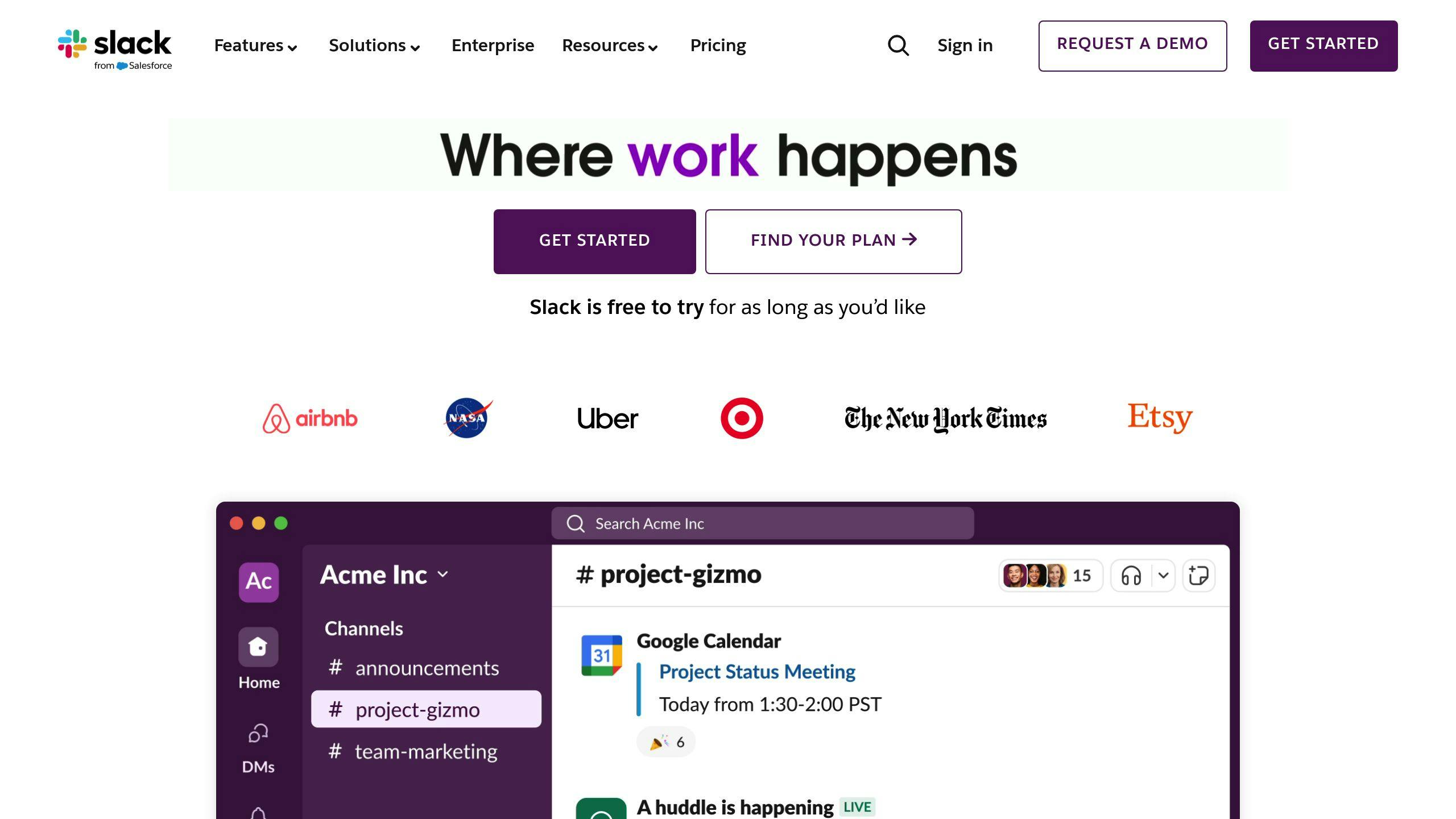
Slack has changed the way digital nomads communicate and work together remotely. It organizes conversations into channels, making it easy to separate projects, updates, and casual chats. Its asynchronous communication feature is especially helpful for bridging time zone differences, while dedicated channels keep project discussions neatly organized and searchable.
You can share documents, images, and even code snippets directly within conversations. Plus, Slack integrates with a wide range of tools, so you can share files or manage tasks without constantly switching apps. Security is a priority, with encryption, two-factor authentication, and customizable access controls ensuring your data stays protected.
For those always on the go, Slack’s mobile app keeps communication running smoothly, even on unreliable internet. Messages sync across devices, so you won’t miss important updates, and customizable notifications help you stay on top of work while balancing personal time.
The free plan includes key features, while paid plans offer extras like unlimited message history and group video calls. While Slack shines in communication, the next tool - Monday.com - takes project management to the next level for digital nomads.
4. Monday.com
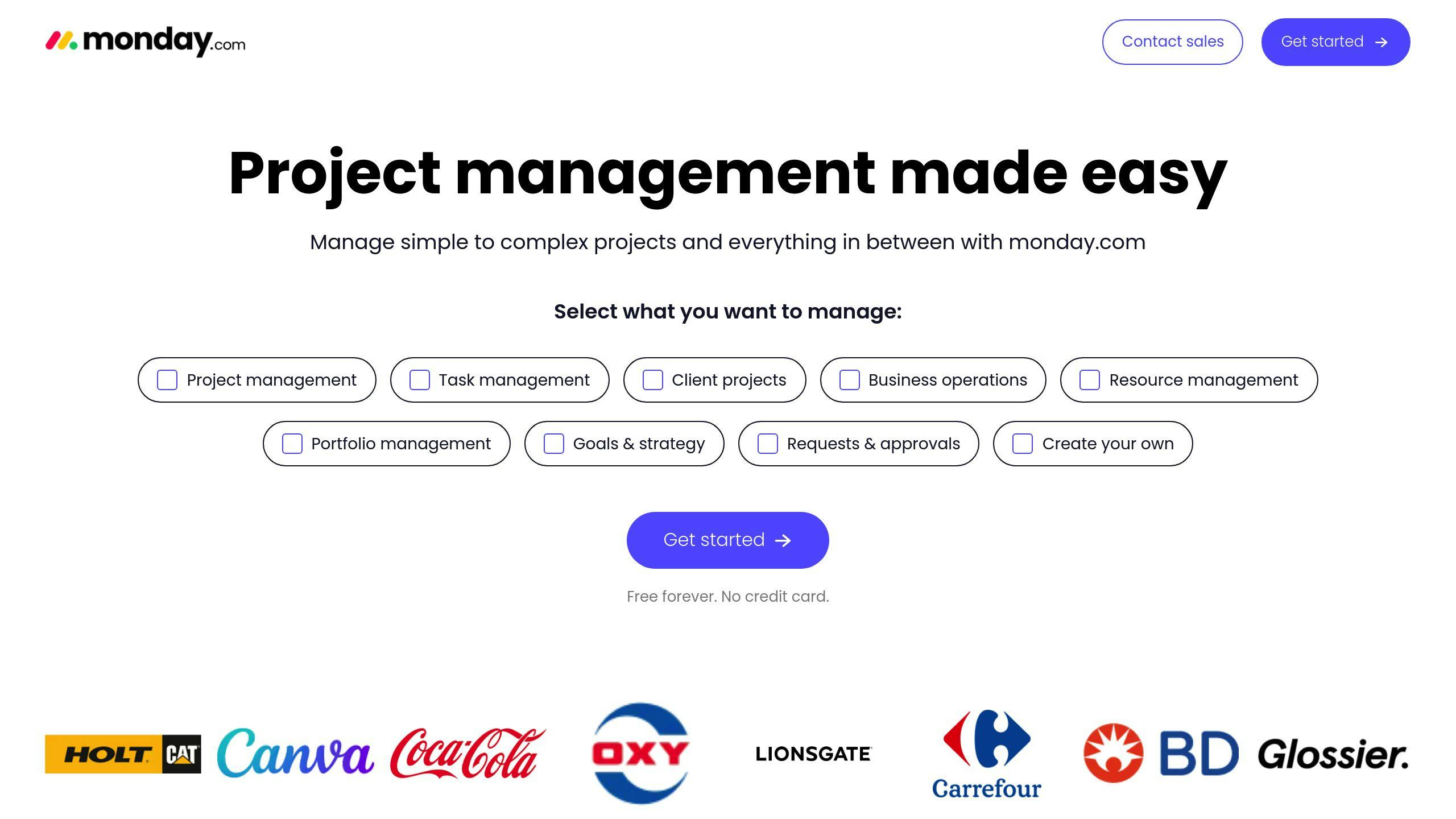
Monday.com is a top choice for digital nomads who need a reliable way to manage projects while staying connected with their team. It combines powerful project management tools with easy-to-use collaboration features, making it ideal for tasks like content planning, client work, or product launches.
The platform's visual interface makes it simple to track progress and stay on top of project milestones, even when working across different time zones. Its file-sharing system acts as a central hub, keeping all project-related documents in one place for smoother teamwork.
One standout feature is the integrated commenting system, which allows team members to communicate directly within tasks. Using comments, tags, and notifications, teams can stay aligned no matter where they are.
| Feature Category | Key Capabilities |
|---|---|
| Project Views | Kanban, Timeline, Gantt charts |
| Communication | Real-time comments, @mentions, updates |
| File Management | Direct file attachments, document organization |
| Integration | Slack, GitHub, Google Drive connectivity |
Monday.com’s structure makes it easy to stay organized when juggling multiple clients or projects. Each project gets its own board, complete with custom fields, statuses, and automation rules. Plus, integrations with tools like Slack, GitHub, and Google Drive reduce the need to constantly switch between apps.
While Slack focuses on communication, Monday.com takes collaboration to the next level by offering a clear framework for managing tasks and workflows. Up next is ClickUp, which brings its own unique spin on task management and customization.
5. ClickUp
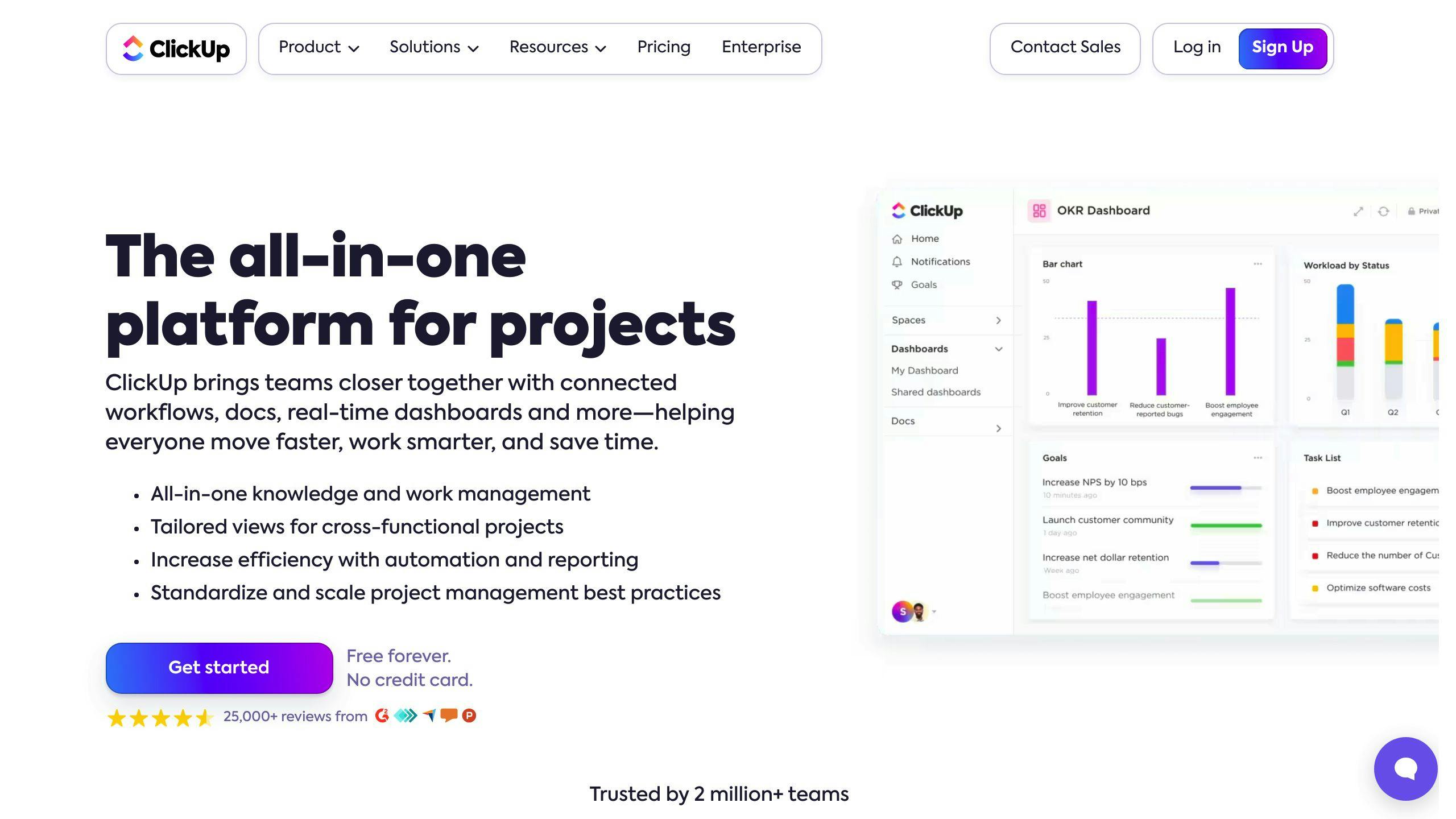
ClickUp takes Monday.com's framework a step further by offering an all-in-one platform that combines project management and communication tools. This makes it a great choice for digital nomads juggling workflows across different time zones.
| Feature Category | Capabilities | Benefits for Digital Nomads |
|---|---|---|
| Project Management | Custom workflows, Gantt charts, Kanban boards | Easy task organization across time zones |
| Communication | Built-in chat, task comments, @mentions | Smooth team coordination in real time |
| File Sharing | Cloud storage integration, document management | Access files from anywhere, anytime |
| Security | Two-factor authentication, data encryption | Keeps remote work secure and private |
ClickUp syncs effortlessly with popular tools, creating a centralized workspace. Its mobile app lets you manage projects on the go, with real-time updates ensuring you're always in the loop.
One of ClickUp's biggest perks? The free plan includes unlimited tasks and users, making it a budget-friendly option for freelancers and small remote teams. If you need more features, paid plans start at just $5/month, adding extras like custom fields and detailed reporting.
For those concerned about data security, ClickUp offers robust measures like encryption and regular backups, keeping your information safe even on public networks.
While ClickUp shines with its customization options and integrations, tools like Microsoft Office Online may appeal to those looking for a more familiar collaboration experience.
sbb-itb-f962a1b
6. Microsoft Office Online
Microsoft Office Online brings together familiar tools like Word, Excel, and PowerPoint with the convenience of cloud-based functionality. Its user-friendly design and reliable features make it a solid option for digital nomads juggling projects across different time zones.
| Feature | Capability | Benefits for Digital Nomads |
|---|---|---|
| Real-time Collaboration | Edit documents simultaneously | Work with others no matter where they are |
| Cloud Storage | Integrated with OneDrive | Access files from any device |
| Security | Encryption and two-factor authentication | Share documents securely on public networks |
| Communication | Teams integration | Effortless chat and video meetings |
With real-time co-authoring, teams can work on the same document at the same time, avoiding version mix-ups. The integration with Microsoft Teams provides a unified space for both collaboration and communication, making it easy to switch between editing and chatting.
OneDrive integration ensures that files are available across all devices, and offline editing with automatic syncing keeps your work on track even if the internet connection is spotty.
For managing projects, Microsoft Office Online connects seamlessly with Microsoft Planner. This allows users to:
- Assign tasks directly within documents
- Set deadlines and monitor progress
- Share updates instantly with team members
The platform also offers affordable plans, making it a practical choice for freelancers and small teams. While Microsoft Office Online is a great all-around tool for collaboration, other platforms like Shortcut cater specifically to software development teams.
7. Shortcut
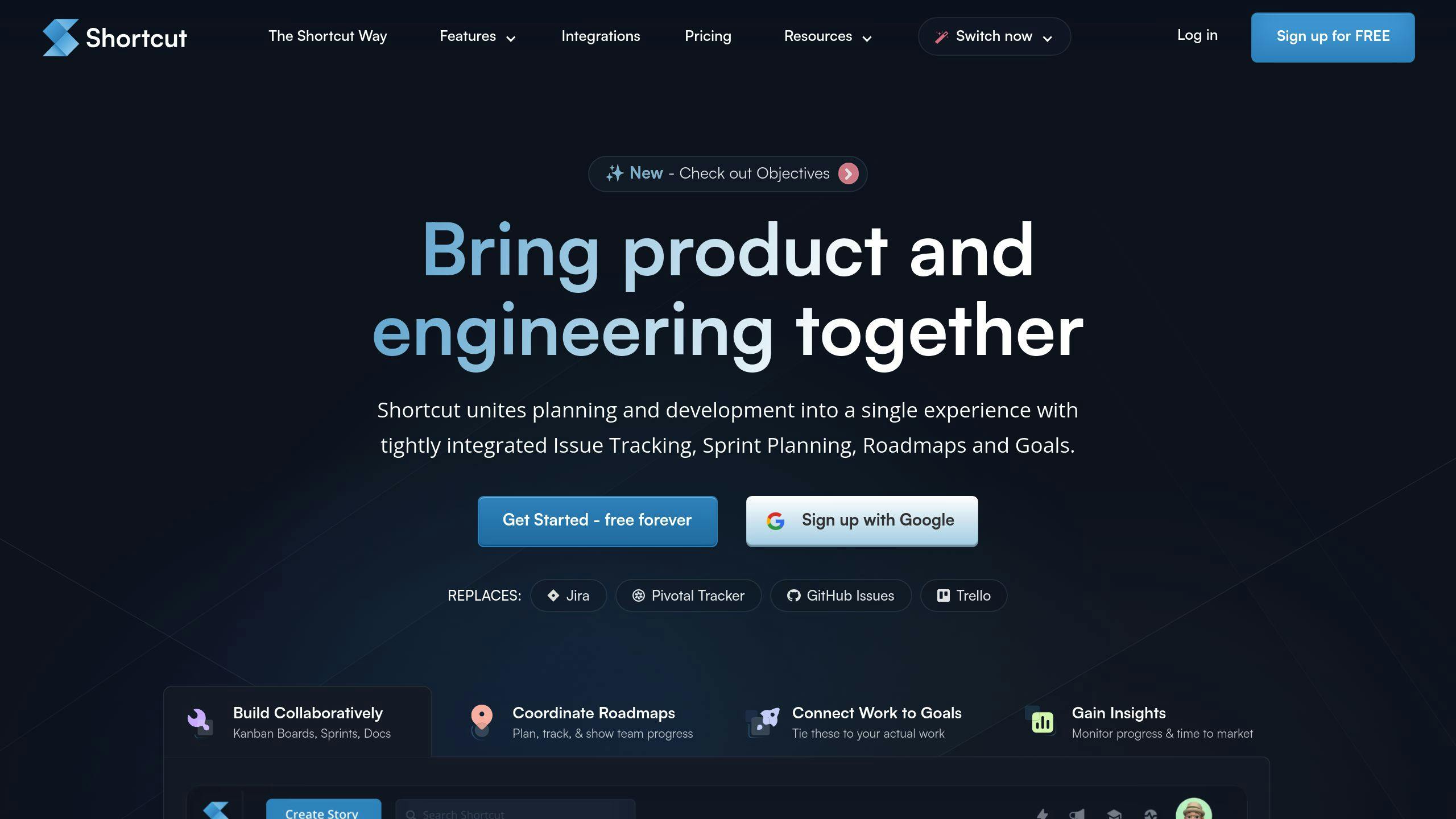
Microsoft Office Online is great for general collaboration, but Shortcut is built with remote software development teams in mind. For tech-focused digital nomads, Shortcut blends agile project management with secure, real-time collaboration, making it easy to stay productive no matter where you are.
| Feature | What It Does | Why It Helps Digital Nomads |
|---|---|---|
| Project Tracking | Kanban boards and sprint planning | Helps track progress across different time zones |
| GitHub Integration | Connects directly to repositories | Simplifies development workflows |
| File Management | Attachments tied to tasks | Keeps files organized and easy to find |
Shortcut’s Kanban boards provide a clear way to monitor progress, even when your team is spread across multiple time zones. Sprint planning tools help keep workflows organized, ensuring everyone stays on track, wherever they are.
Security is another key advantage. With secure access controls, Shortcut is ideal for digital nomads working from public Wi-Fi or shared spaces. It integrates seamlessly with GitHub for code management and Slack for instant updates, creating a centralized workspace for development teams.
To get the most out of Shortcut, teams should:
- Use Slack integration for instant communication
- Leverage Kanban boards for transparency
- Attach documentation directly to tasks for better organization
While Shortcut may not cover everything a general collaboration tool does, its developer-focused features make it a powerful tool for digital nomads in tech. And if you're in a creative field, tools like Figma offer a similarly specialized experience.
8. Figma

Figma is a go-to tool for digital nomads managing design projects across the globe. Its cloud-based platform eliminates the need for local software, allowing teams to work seamlessly through a browser. Whether you're dealing with spotty internet or frequently switching devices, Figma ensures uninterrupted access to your projects.
| Feature | Benefit for Digital Nomads | How It Works |
|---|---|---|
| Real-time Design Collaboration | Teams can work on designs simultaneously | Live cursors show team activity |
| Cloud Storage | Access files anytime, anywhere | Auto-save with offline backups |
| Development Integration | Smooth design-to-code handoff | Automated asset exports |
| Interactive Prototyping | Quick design validation | Shareable prototype links |
The platform's real-time editing keeps everyone on the same page, no matter the time zone. Its built-in commenting system simplifies feedback by allowing stakeholders to leave notes directly on the designs, cutting down on endless email threads.
Tips for maximizing Figma's potential as a remote designer:
- Create reusable design components to maintain consistent branding.
- Use version history to keep track of changes, especially when working across different time zones.
- Take advantage of responsive design tools to build layouts that adapt to various screen sizes.
Figma offers a free plan for individual users, while paid plans start at $12 per user per month, unlocking advanced collaboration tools. Integration with apps like Slack and GitHub further streamlines workflows, making it easier for remote teams to access and share design assets.
For digital nomads in the design field, Figma is a must-have. Up next, we’ll dive into another tool that combines collaboration with travel-friendly features.
9. Zoom

Zoom has become much more than a video call app - it's now a go-to collaboration tool for digital nomads in 2025. Its features are designed to make working with teams and clients across the globe easier and more efficient.
| Feature | Benefit for Digital Nomads | Integration Capability |
|---|---|---|
| HD Video Conferencing | Clear communication from anywhere in the world | Works well with low bandwidth and cloud tools |
| Smart Recording | Record meetings for teammates in different time zones | Syncs with popular storage platforms |
| Virtual Whiteboard | Brainstorm and collaborate visually in real time | Works with design tools |
| Breakout Rooms | Perfect for small group discussions | Handles multiple sessions at once |
With end-to-end encryption and password-protected meetings, Zoom keeps your conversations secure - a must for digital nomads handling sensitive client projects.
Tips for Getting the Most Out of Zoom:
- Use automatic recording and noise cancellation to manage meetings across time zones or in noisy environments.
- Take advantage of integrations with tools like Google Drive and Slack for easy file sharing.
- Switch to low-bandwidth mode when your internet connection is shaky.
Zoom’s AI-powered features, like meeting summaries and transcription, save time by simplifying follow-ups. Its smart video technology adjusts quality based on your internet connection, and the mobile app ensures you can join meetings or share files directly from your phone when a laptop isn’t handy.
The platform offers flexible pricing with free and paid plans to suit different needs. Calendar integrations also help adjust meeting times automatically based on participants' locations.
While Zoom is excellent for communication, the next tool focuses on offering a wider range of resources tailored for digital nomads.
10. GTFO.co
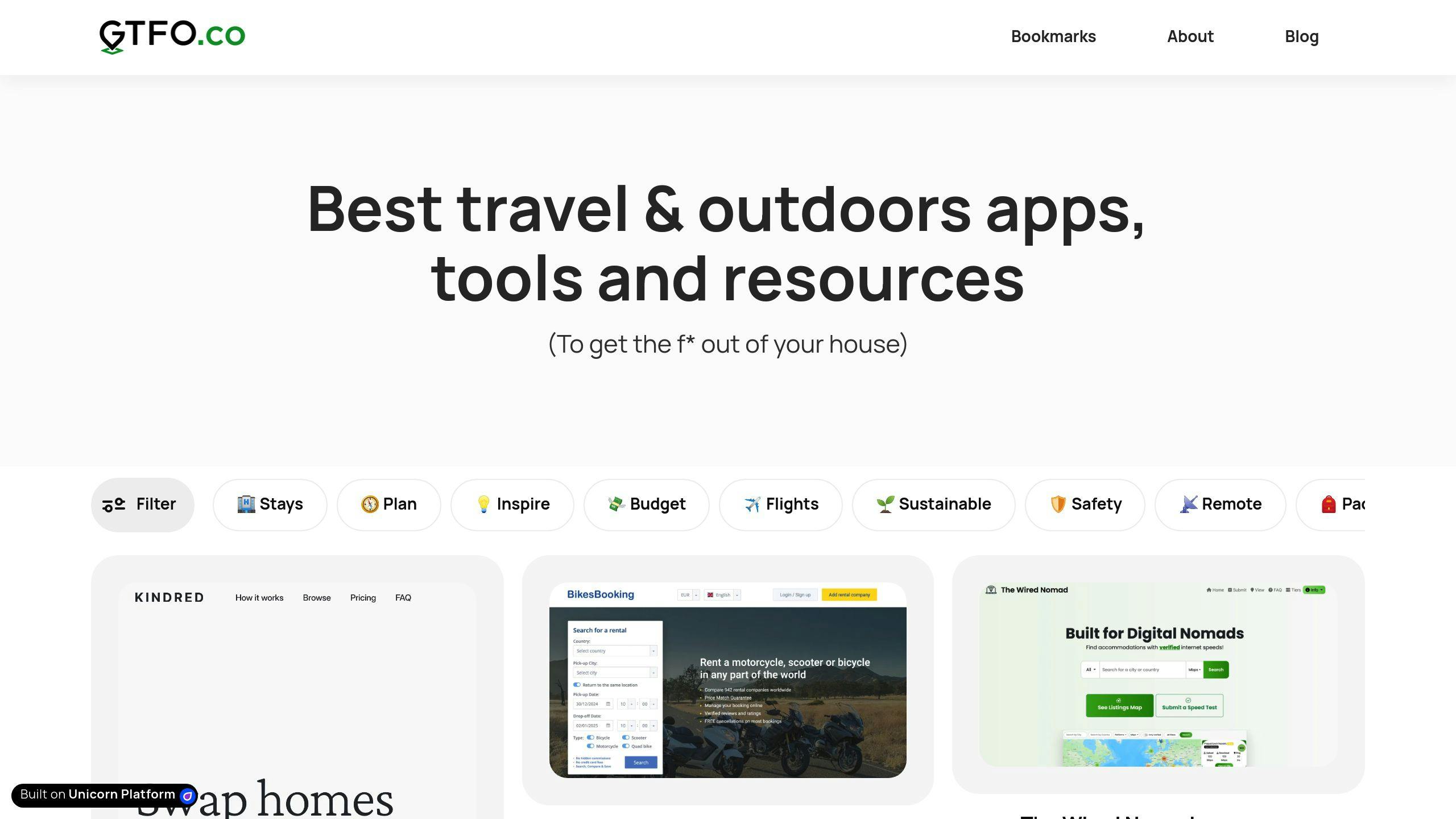
GTFO.co isn’t your typical collaboration platform, but it’s a handy resource for digital nomads managing a remote lifestyle. This curated directory of travel tools and services helps simplify travel planning, freeing up more time to focus on work.
Here’s what GTFO.co offers:
- Flight search tools to find the best deals.
- Accommodation comparison services to explore lodging options.
- Local recommendations for dining, activities, and more.
- Navigation apps for seamless travel.
- Safety resources to stay informed and prepared.
- eSIM services through Airalo for easy mobile connectivity.
- Visa services via iVisa for hassle-free travel documentation.
While GTFO.co isn’t designed for direct collaboration, it complements the tools mentioned earlier by helping digital nomads handle travel logistics efficiently. Use it to streamline your planning, so you can stay productive while on the move. For actual collaboration, stick to the specialized platforms covered in previous sections.
Conclusion
Choosing the right tools can make all the difference for digital nomads managing remote work. These tools help tackle core needs such as communication, teamwork, and staying on top of projects.
To collaborate effectively, mix and match tools based on what works best for you. File-sharing and messaging platforms ensure secure, real-time updates, while video conferencing keeps those face-to-face interactions alive no matter where you are.
Platforms like Monday.com and ClickUp simplify project management with workflows that can grow with your needs. If your work leans on visuals, tools like Miro and Figma are excellent for brainstorming and creative tasks.
When evaluating tools, focus on these key factors:
- How well they integrate with your existing setup
- Whether they can grow with your team or projects
- Built-in security features
- Accessibility on mobile devices
Take advantage of free trials to test different options before committing. By addressing challenges like time zones, connectivity, and secure data sharing, these tools can help digital nomads stay productive and connected.
With the right setup, remote work becomes much more manageable. Up next, we'll dive into common questions about collaboration tools.
FAQs
What is the best Slack alternative?
For digital nomads already using Google Workspace, Google Chat is a strong contender as a Slack alternative. With a 4.5/5 rating on Capterra from 2,115 reviews [1], it works seamlessly with Google Workspace tools like Drive and Calendar, creating a unified workflow for $6 per user per month.
Here’s why Google Chat might be a great fit:
- Smooth integration with Google Workspace tools
- Easy-to-use, streamlined interface
- Real-time collaboration features
- Designed for mobility and remote work
While Slack has a slightly higher Capterra rating of 4.7/5 [2], thanks to its broad customization options and third-party integrations, Google Chat's simplicity might appeal to those who prefer a less complex setup. For digital nomads, the focus on mobility and ease of use makes Google Chat a practical choice.
Microsoft Teams, on the other hand, caters more to larger organizations with intricate workflows, which might not align well with the needs of solo digital nomads or small teams [2].
When deciding between these platforms, think about:
- Your current tools and integration needs
- The size of your team and how you communicate
- Budget considerations
- Specific features needed for your workflow
The best choice will depend on your unique requirements and the tools you already use, so take time to evaluate which platform supports your mobile work style the best.


